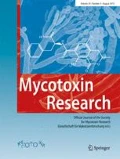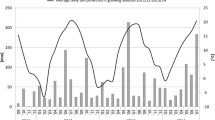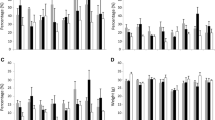Abstract
At anthesis, under field conditions at Fundulea, each of 6 Romanian winter wheat genotypes was inoculated with 3Fusarium graminearum isolates used individually.Fusarium head blight (FHB) was assessed according to the following traits: relative weight of spikes (RWS), percentage of Fusarium damaged kernels (FDK), relative weight of kernels per head (RWKH), area under the disease progress curve (AUDPC) and deoxynivalenol (DON) content in total sample of kernels. Correlations between these traits and parameters revealed important differences between examined wheat genotypes in: DON accumulation, progress of FHB development, yield reduction, and models of host — pathogen interactions in theTriticum - Fusarium pathosystem. Significant correlations between different attributes of FHB were found forFusarium isolate 1 which is a moderate producer of DON (0.89 µg g-1). Weight of spike was significantly correlated with weight of kernels per spike (r = 0.93**) and with percentage of damaged kernels (r = - 0.87**), while FDK was highly correlated with RWKH (r = - 0.85*) and with DON content (r = 0.82*). Area under the disease progress curve was also found to be significantly correlated with DON content (r = 0.86*).
Similar content being viewed by others
References
Chelkowski, J., (1994). Significance ofFusarium metabolites in interaction between a cereal plant and pathogen. Genetica Polonica 35B: 137–142.
Gang, G., T. Miedaner, U. Schuhmacher, M. Schollenberger & Geiger, H.H. (1998). Deoxynivalenol and nivalenol production byFusarium culmorum isolates differing in aggressiveness toward winter rye. Phytopathology 88, 9: 879–884.
Golinski, P., M. Kostecki, I. Lasocka, H. Wisniewska, J. Chelkowski & Kaczmarek, Z. (1996). Moniliformin accumulation and other effects ofFusarium avenaceum (Fr.) Sacc. on kernels of winter cultivars. J. Phytopathology 144: 495–499.
Ittu, M., Sãulescu, N. N. & Ittu, G. (1989). New elements in the breeding strategy for disease resistance in wheat. (Rom.) Probl. Genet. Teor. Aplic. 21:123–147.
Ittu, M., Sãulescu, N. N. & Ittu, G. (1994). Criteria for estimation ofFusarium scab resistance in wheat. Romanian Agricultural Research 1:19–23.
Ittu, M., Sãulescu, N. N. & Ittu, G. (1997). Stability of response to FHB in a collection of Romanian winter wheat genotypes under artificial inoculation. Proceedings of the Conference “Approaches to improving disease resistance to meet future needs: Airborne pathogens of wheat and barley”, COST Action 817, 11-13 November 1997, Praha, Czech Republic: 56–60.
Ittu, M., Sãulescu, N. N. & Ittu, G. (1998). Breeding wheat for resistance toFusarium Head Blight in Romania. In: H.J. Braun {etet al.} (Eds.), Wheat: Prospects for Global Improvement: 87-92. Kluwcr Academic Publishers. Printed in the Netherlands.
Lemmens, M., Josephs, R., Schuhmacher, R., Grausgruber, H., Buerstmayr, H., Ruckenbauer, P., Neuhold, G., Fidesser, M. & Krska, R. (1997). Head blight (Fusarium spp.) on wheat: investigations on the relationship between disease symptoms and mycotoxin content. Proceedings of the Fifth EuropeanFusarium seminar, Szeged, Hungary, 29 August-5 September, 1997: 459–465.
Mesterhazy, A., (1987): Selection of wheat blight resistant wheat through improved seedling resistance. Plant Breeding 98: 25–36.
Mesterhazy, A. & Bartok, T. (1993). Resistance and pathogenicity influencing toxin (DON) contamination of wheat varieties followingFusarium infection. Hod. Rosl. Aklim. Nasien. 37: 9–15.
Miedaner, T., (1997). Review. Breeding wheat and rye for resistance toFusarium diseases. Plant Breeding 116: 201–220.
Miller, J. D., Young, J. & Sampson, D. R. (1985). Deoxynivalenol andFusarium head blight resistance in spring cereals. J. Phytopathology 113: 359–367.
Miller, J. D. & Arnison, P. G. (1986): Degradation of deoxynivalenol by suspension cultures of theFusarium head blight resistant cultivar Frontana. Can. J. Plant Pathology 8: 147–150.
Mirocha, C. J., Abbas, H. K., Windels, C. E. & Xie, W. (1989). Variation in deoxynivalenol, 15-acetyldeoxynivalenol, 3-acetyldeoxynivalenol, and zearalenone production byFusarium graminearum isolates. Appl. Environ. Microbiol. 55: 1315–1316.
Parry, D. W., Jenkinson, P. & McLeod, L. (1995).Fusarium ear blight (scab) in small grain cereals - a review. Plant Pathology 44: 207–238.
Perkowski, J., Miedaner, T., Geiger, H. H., Müller, H. M. & Chelkowski, J. (1995). Occurrence of deoxynivalenol (DON), 3-acetyl-DON, zearalenone, and ergosterol in winter rye inoculated withFusarium culmorum. Cereal Chem. 72: 205–209.
Perkowski, J., Stachowiak, J., Kiecana, I., Golinski, P. & Chelkowski, J. (1997). Natural occurrence ofFusarium mycotoxins in Polish cereals. Cereal Res. Comm. 25, 3/1:379–380.
Pomeranz, Y., Bechtel. D. B., Sauer, D. B. & Seitz, L. M. (1990).Fusarium head blight (scab) in cereal grains. Adv. Cereal Sci. Technol. 10: 373–433.
Sãulescu, N. N., (1993). An evaluation of present wheat breeding priorities for Romania. (Rom) Lucrãri stiintifice U.S.A.B. 24(1): 39–47.
Scott, P. M., (1990). Trichothecenes in grains. Cereal Foods World 35: 661–666.
Schroeder, H.W. & Christensen, J. J. (1963). Factors affecting resistance of wheat to scab caused by Gibberella zeae. Phytopathology 53: 831–838.
Sinha, R. C. & Savard, M. E. (1997). Concentration of deoxynivalenol in single kernels and various tissues of wheat heads. Can. J. Plant Pathology 19: 8–12.
Snijders, C.H.A. & Perkowski, J. (1990). Effects of head blight caused byFusarium culmorum on toxin content and weight of wheat kernels. Phytopatholology 80: 566–570.
Tanaka, T., Hasegawa, A., Yamamoto, Y., Lee, U. S., Sugiiura, Y. & Ueno, Y. (1988). Worldwide contamination of cereals byFusarium mycotoxins nivalenol, deoxynivalenol and zearalenone. 1. Survey of 19 countries. J. Agric. Food Chem. 36: 980–983.
Van Eeuwijk, F. A., Mesterhazy, A., Kling, Ch. I., Ruckenbauer, P., Saur, L., Bürstmayr, H., Lemmens, M., Keizer, L. P. C, Maurin, N. & Snijders, C. H. A. (1995). Assessing non-specificity of resistance in wheat to head blight caused by inoculation with European strains ofFusarium culmorum, F. graminearum andF. nivale using multiplicative model for interaction. Theor. Appl. Genet. 90: 221- 228.
Vesonder, R. F. & Golinski, P. (1989). Metabolites of Fusarium. In J. Chelkowski (Ed)Fusarium: Mycotoxins, Taxonomy and Pathogenicity. Elsevier: 1–39.
Wakulinski, W. & Chelkowski, J. (1993).Fusarium species causing scab of wheat, rye and triticale in Poland. Hod. Rosl. Aklim. Nasien. 37: 137–141.
Wang Y.Z. & Miller, J. D. (1988). Effects ofFusarium graminearum metabolites on wheat tissue in relation toFusarium head blight resistance. J. Phytopathology 122: 118–125.
Author information
Authors and Affiliations
Rights and permissions
About this article
Cite this article
Ittu, M., Grabarkiewicz-Szczesna, J., Kostecki, M. et al. Deoxynivalenol accumulation and other scab symptoms in six romanian wheat genotypes inoculated withFusarium graminearum . Mycotox Res 16, 15–22 (2000). https://doi.org/10.1007/BF02946102
Received:
Accepted:
Issue Date:
DOI: https://doi.org/10.1007/BF02946102




